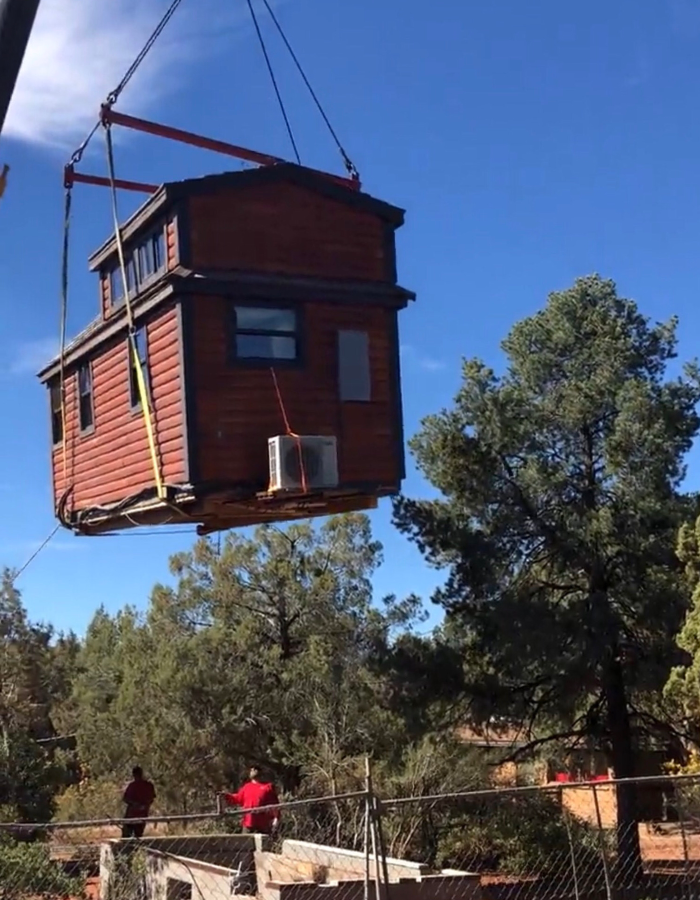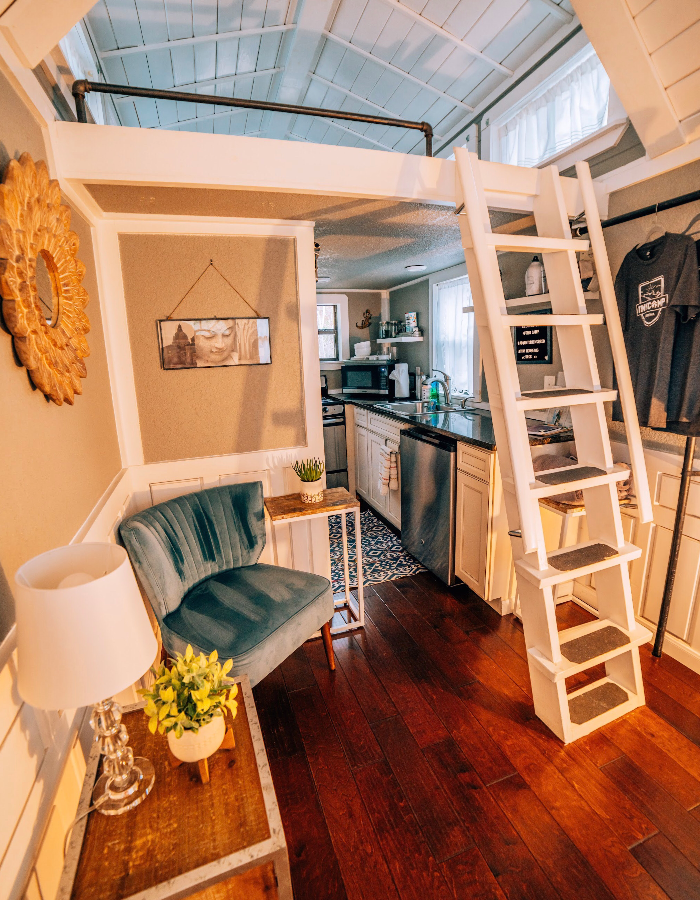David M. Brown
Arizona residents and tourists have made Sedona a must-visit destination nearly equal to the draw of the Grand Canyon. With its iron-infused red sandstone monuments and spiritual vortexes, the Red Rocks, and adjacent Oak Creek Canyon, Sedona is a destination that many dream about making home. For Sedona teachers, it may always only be a dream. Sedona, along with many resort communities, poses a challenge of affordability for its teachers and other workers and poses a need for them to commute into the town for work.
To address this challenge, the Sedona Charter School has innovatively offered on-grounds housing for two of its teachers, most recently Haley Seiber, a teacher who moved to Arizona from Florida five years ago.
Six years ago, the school and its benefactors lifted a 152-square-foot tiny house with a loft and front deck onto the property in an effort to accommodate at least one teacher’s housing needs. The log-cabin-style home matches the character of the 1922 Bennett-Purtymun log cabin on the property, Sedona’s oldest, which the school uses for environmental education.
Founded in 1995, Sedona Charter School is Arizona’s oldest charter school, serving the needs of a broad-based demographic of roughly 140 students. In 2001, the Montessori-anchored school moved to its four-acre West Sedona campus. Seiber, with a bachelor’s degree from St. Petersburg College, welcomed the opportunity to teach where the school’s values aligned with her own. And, living and working in one of the world’s most beautiful places, she could easily enjoy her passions of hiking and connecting with nature.
“The provision of housing was a significant factor in her decision to accept the position and has contributed to her retention for four to five years in the area,” says urban planner and developer Darin Dinsmore of Seiber. Dinsmore is the founder and principal of Sedona-based TinyCamp, which made the home available for the school.
His company offers luxury, eco-friendly tiny home vacation retreats in Oak Creek Canyon and nearby Cottonwood, where individuals and couples re-center in quiet, inspiring locations, to further wellness, spirituality, sustainability, and connectedness to the natural world. TinyCamp Sedona and TinyCamp Cottonwood were recently certified under the Friends of the Verde River’s River Friendly Living program, highlighting a commitment to sustainability and environmental stewardship.
Citing Zillow, Dinsmore explains that the median price of a single home in Sedona is $918,780.
“Such financial barriers make it difficult for teachers, local employees, and government workers to afford living in Sedona,” he says. “This home is part of a mission to construct a sustainable, long-term housing solution aimed at attracting and retaining teachers in Sedona.”
John Griffin, a retired builder living in Sedona and member of the school’s board of directors, adds that the school project is part of an ongoing community effort to build more affordable housing in the area. A number of years ago, he led a group in building a performing arts center/classroom at the school.
 The recent surge of high-priced short- and long-term rental sites, such as Airbnb, has intensified this housing problem.
The recent surge of high-priced short- and long-term rental sites, such as Airbnb, has intensified this housing problem.
“The quality of the education of our youth is vital,” Griffin says. “When teachers can’t even afford to live in the town where they’re teaching — that’s not ideal.”
Another teacher occupied the tiny house first, but she returned to Phoenix to tend to family, and the school offered its use to Seiber.
Seiber recalls, “It definitely solidified my decision to move and to work at the school because I don’t know how I would have done it any other way.”
San Antonio Opens the Door to Oak Creek and Sedona
The tiny home at Sedona Charter School traveled a long way to its current home.
About five years ago, Dinsmore met the mayor of San Antonio at the World Changing Conference in Montreal. She told him about working with the Construction Careers Academy to further sustainable development practices in the city through the fabrication of tiny homes.
He connected with the group and began a mentoring program with the students to provide feedback on designs and ensure that the tiny homes meet local building codes and are able to be approved by local jurisdictions. Dinsmore purchased five of these student-built houses and shipped them to Sedona.
One of these became a demonstration unit for tiny house living in picturesque Oak Creek Canyon just north of Sedona. Dinsmore’s company was one of the first participants in Coconino County’s sustainable building program, which helped facilitate innovative solutions in sustainable housing, including its first tiny house ordinance.
Soon after, Dinsmore’s realtor — a Sedona Charter School board member — showed interest in the project and informed the school’s principal at the time, Alice Madar. The small public school could not afford to pay high salaries for teachers, and after Arizona forbade restrictions on short-term rentals in the mid-1970s, property owners were rapidly converting homes to rentals, making it difficult for families and school staff to find homes, Madar recalls.
When the tiny house project began on Sedona Charter School’s campus, one teacher was already living on campus in a small cabin.
Madar notes, “She indicated that if she had to try to find market-rate housing off campus, she would have had to leave the school. We wanted to hire some younger teachers but we could not pay top salary, and interested candidates could not find affordable housing. We joked about throwing up a tiny house over the summer and hiring a teacher who could live there.”
She connected with Dinsmore and found that he not only had one available, but could help the school work through the regulatory and entitlement process, amend its housing codes, and use the tiny house as a demonstration project for sustainable housing.
Dinsmore brought in his team of contractors to expedite the project, including the foundation and fire-sprinkler system. He postponed income-producing opportunities to help the school facilitate a fast-track solution, so a new teacher could move in before the fall semester — a process that might have taken several years otherwise.
“This is a critical time when there is absolutely no housing available in the area, so the teacher would have probably had to have commuted from Rimrock [a town about 20 miles south of Sedona] to be able to afford to live in the area,” he says.
The city showed class, too, recognizing the teacher-housing problem in general and helping to facilitate short-term solutions and envisioning long-term ones. Steve Mertes, the city’s director of community development, was the chief building official when the tiny house was installed at the school. Together with Madar, he worked to obtain the necessary permits.
San Antonio’s plumbing, electrical, and mechanical inspectors had already approved the home, and Mertes was able to use a provision in the Sedona Building Code which permits the relocation of a building approved by another jurisdiction.
In addition, to meet IRC requirements, the city worked with Dinsmore to put the house on an approved foundation and provide permanent utility hookups.
“This critical support came at a time when housing availability in Sedona was scarce, demonstrating the city’s commitment to innovative housing solutions,” Madar said. “This initiative has notably improved teacher retention and enhanced the quality of teaching and extracurricular activities.”
A first for the city, this is also the smallest home ever approved for the municipality. Still, the tiny house filled a specific need in this instance and would serve as a major player in building affordable workforce housing, Dinsmore says.
“We need greater density to make a bigger impact. But every little bit helps.”
 The recent hiring of a housing coordinator by the city of Sedona signifies ongoing efforts to address housing challenges, Dinsmore says, adding, “We need a wide range of housing types, including apartments, fourplexes, townhomes, and tiny homes. These can be a part of the solution for higher density, what we call in the business ‘gentle density,’ more walkable communities. This may work in a place such as Sedona that is sensitive to overdevelopment.”
The recent hiring of a housing coordinator by the city of Sedona signifies ongoing efforts to address housing challenges, Dinsmore says, adding, “We need a wide range of housing types, including apartments, fourplexes, townhomes, and tiny homes. These can be a part of the solution for higher density, what we call in the business ‘gentle density,’ more walkable communities. This may work in a place such as Sedona that is sensitive to overdevelopment.”
Grandly Green
In addition to solving an employee-housing issue at the school, as mentioned, the tiny house is a model for eco-friendly living and educational opportunities in sustainable practices, Dinsmore explains. Among its sustainable elements:
- Material Use Efficiency — The tiny house requires less construction material per capita compared with conventional homes.
- Energy Consumption — The tiny house aligns with sustainability goals by reducing the demand on energy resources and potentially incorporating renewable energy sources for self-sufficiency.
- Reduced Carbon Footprint — The home contributes to lower greenhouse gas emissions and supports global efforts to combat climate change.
- Land Use Efficiency — The house demonstrates an efficient use of space, which can contribute to preserving natural habitats and reducing urban sprawl.
- Dark Sky Community Participation — The tiny home does not add light pollution to the area.
- Lifestyle and Sustainability — This lifestyle prioritizes sustainability, minimalism, and a reduced ecological footprint.
- Zero Commute for Its Resident — Living on campus eliminates the need for daily commuting, significantly reducing the teacher’s carbon footprint associated with travel. This contributes to lower greenhouse gas emissions and decreased air pollution.
The Teacher Learns
Four years in the tiny house have been comfortable, scenic, educational, and convenient.
“It was a great way for me to get to know the area and be centrally located next to work,” Seiber says. “The location has a wonderful view of Thunder Mountain from the kitchen and loft area, and proximity to hiking trails is great too,” she adds.
What’s more, she’s learning from the home: “Living in the tiny house has made me more conscious of only buying things that are essential or that I really need. Because of the small space, I really have to be aware of what I’m buying and what I need to get rid of.”
At first, she thought tiny house living would be difficult, but she notes, “It’s actually pretty easy once you really settle into the idea.” She’s experienced just one downside: entertaining large groups. “I have had a couple friends come and visit, and we utilize the outside porch a lot.”






